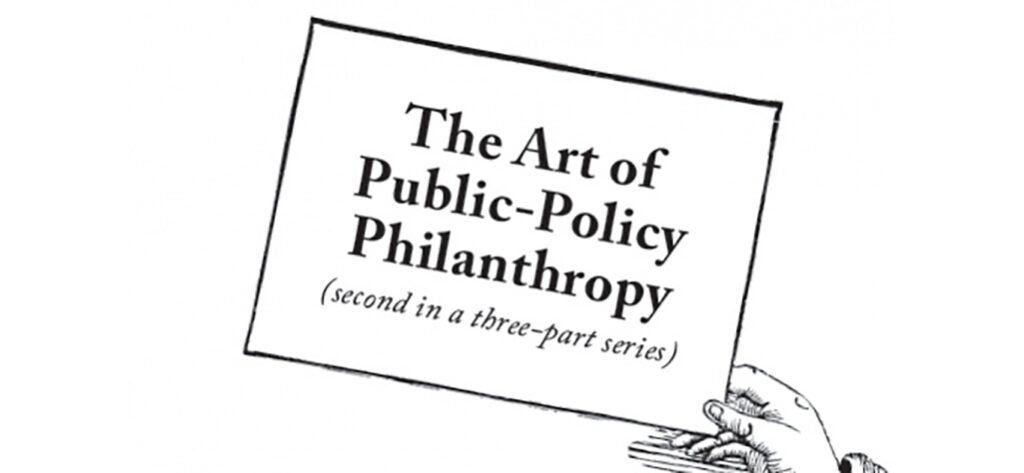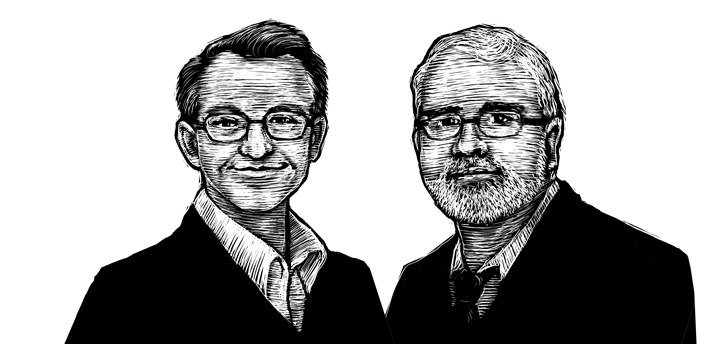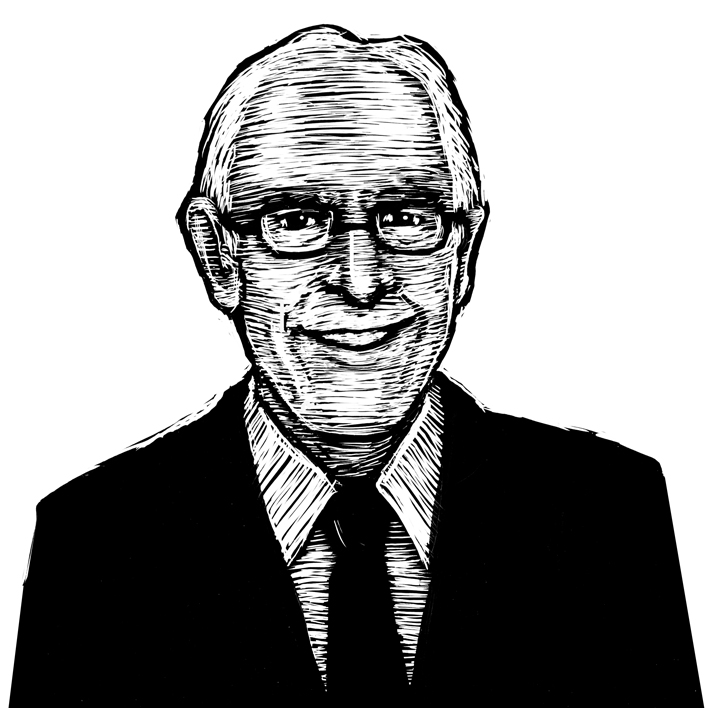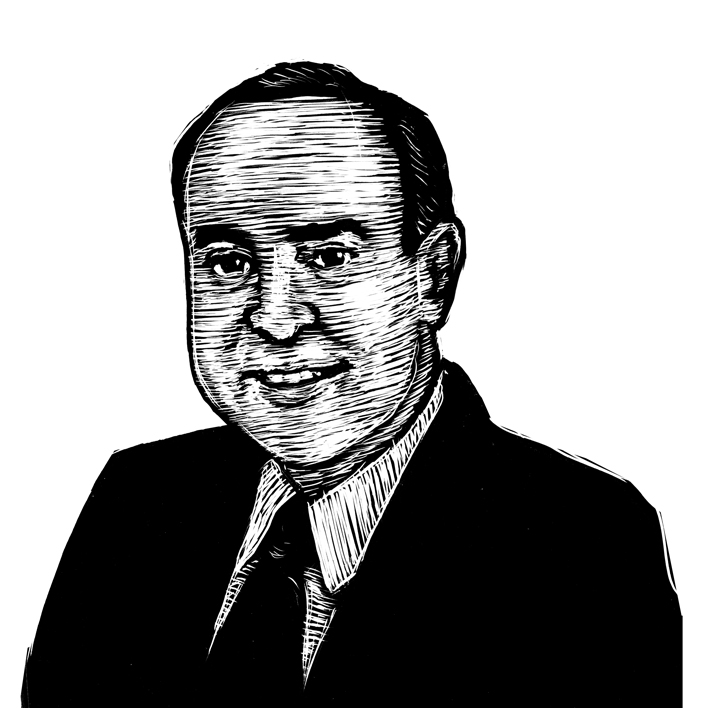
In three consecutive issues of Philanthropy we are presenting wisdom from America’s leading experts on public-policy philanthropy. This niche—where donors aim to nudge national opinion and lawmaking in constructive directions—is a difficult art, but one that can have large payoffs for those who understand its mysteries.
In this installment, our authorities look at investing in various forms of legal action as a way for donors to solve problems and improve society. And a sidebar notes that this is not a field for philanthropists seeking immediate gratification. These expert testimonies are condensed from the new Philanthropy Roundtable book Agenda Setting: A Wise Giver’s Guide to Influencing Public Policy.
Seamus Hasson & Bill Mumma
At the Becket Fund, founder Seamus Hasson and president Bill Mumma have relied on donors who understand the long-term importance of their strategy. Providing free, first-rate legal representation to practitioners of all religious faiths when they come under pressure has been Becket’s mission from the beginning. In the process, the nonprofit law firm not only aids individuals under duress, but sets precedents in our top courts that protect the religious freedoms of all Americans.
Religious liberty became a passion of Seamus Hasson very early. “I actually went to law school with the idea of creating a public-interest firm that would defend religious liberties. At the time, religious freedom was a divisive issue. One side was saying ‘religion is bad for you, almost like smoking. It’s something you can do in private if you really want to, but whatever you do, don’t do it in public.’ On the other side, the common argument was simply, ‘This is a Christian country,’ which was legally and historically incorrect.”

“So we had a growing problem. Courts were stripping people of their right to follow their conscience and express themselves religiously. But the public counterarguments were weak. What was needed was a defense of religious pluralism.”
“I founded the Becket Fund to represent all religions. Anglicans to Zoroastrians, I like to say. We don’t endorse the faiths, just the individual’s right to practice.”
“Many potential donors said we’d get more supporters if we focused on just Christians. But there were already people doing that. And they weren’t winning the culture war. Fortunately we found donors willing to try a new tack: the Randolph, Bradley, and Olin foundations, and one little old lady.”
“Our first notable case involved The Beginner’s Bible. Zack was a first grader in a New Jersey public school. The teacher had an activity where students brought their favorite books to read in front of the class. His favorite book was a cartoon version of the Bible, and he wanted to read the story of Jacob and Esau. It didn’t even mention the word God. But his teacher told him he couldn’t read that publicly in school.”
“Zack’s mom felt this was a violation of freedom of expression. So we went to war,” states Hasson. “About the same time, we fought for a Muslim police officer who wanted to grow his beard. Our donor roster grew after these cases. We started with a $300,000 annual budget and quickly rose to $5 million.”
Several other top-flight public- interest law firms focused on protecting religious freedom have grown up in parallel over the past two decades. For instance, the same year Hasson founded Becket, the Alliance Defense Fund was created to offer a counterbalance to the ACLU on issues of church and state. Now known as the Alliance Defending Freedom, the group has been influential in Supreme Court decisions, legal training, public education, and other areas.
Becket Fund president Bill Mumma notes that “by definition, religious liberty is about the law, so building a religious- liberty movement requires law firms. A range of firms have grown up, but they aren’t antithetical to each other. They all take on different aspects of the fight. Our mission is very focused on higher-level appeals that will set a precedent.”
“A donor might say, ‘The local school district stomped on this poor Christian teacher. You ought to take that case. This person is suffering.’ That’s true, yet it may not be a case the Becket Fund can take. If it’s in an area of law that has already been established in favor of the teacher our answer is ‘Get yourself a good lawyer. You’re going to win.’ Our limited resources need to be reserved to carving out new protections and precedents in areas where the law is not yet clearly in favor of religious liberty.”
“We have relied on donors who understand the importance of strategy and case selection. Some of them have been helpful in identifying cases.”
“For future litigation, one of our areas of interest is the Blaine Amendments. In the early 1900s, Senator Blaine tried to pass a Constitutional amendment that would prevent public money from going to Catholic schools. His federal effort failed, so he went to the states and asked them to add Blaine amendments to their state constitutions, prohibiting public funding of church-connected schools.”
“The Ku Klux Klan got involved. Anti-Catholic sentiment was really hot. The public feeling eventually passed away, but Blaine amendments remain on the books in states all across America. Now instead of Protestants fighting Catholics over these amendments, it’s anti-religious groups fighting defenders of religious freedom. Helping the religious-freedom side win will require a long campaign.”
“Another effort we’re pursuing with donor support is to protect people’s ability to practice their profession without committing acts that are contrary to their religious views. This is an issue in health care, where nurses and doctors are sometimes forced to agree to participate in abortion, for instance. If an employer were to say ‘no Catholic doctors allowed,’ that obviously would be impermissible. But conscience rights for religious professionals are not well-protected.”
“Another frontier is at universities that are now saying it’s discriminatory for student groups to require their leaders to share the central convictions of the group. A Christian student association cannot require its president to believe in Jesus Christ. If a group of atheist students show up at the public meeting and vote an atheist as president of the Bible study, it has to be accepted. We think that’s a violation of religious liberty.”
Philanthropists interested in religion will increasingly find it impossible to avoid law and public policy, says Mumma. “All the religions of the world occupy themselves with marriage, births, raising of the family, sickness, old age, and death. As governments grow bigger and intrude more and more in these areas, government enters space that was formerly staked out by religious organizations. It dictates issues where people look to religion for answers. This clash is intrinsic to the expansion of the government. So legal action and political action are required to sort this out.”
“If defenders of religious freedom have the resources to fight, I am optimistic about what will happen over time. But it’s like tuning a piano or a guitar. Every so often you have to go back and tighten the strings.”
Dick Weekley
In 1993, Dick Weekley attended a presentation detailing how litigation was driving businesses out of his home state of Texas. Doctors were leaving their medical practices or retiring early. Businesses were reluctant to expand in the state because of abusive lawsuits.
Weekley knew this was a crisis and somebody had to fix it. But “I had no time to lead the effort,” says the homebuilding entrepreneur. Nobody else stepped up, though. So he became the man who brought legal reform to Texas.
There was a reason other people kept their heads down. The Texas Trial Lawyers Association, known as “the Trials,” was the most powerful special-interest group in the state. For a generation, the Trials had preyed on hospitals and businesses, driving up the cost of everything. “There was no effective opposition,” says Weekley. “This problem was in the process of destroying the state.”

Weekley and several of his friends had tried to support existing organizations. “Before long, we recognized that we needed to try something different—we needed a new organization that would think out of the box,” he says.
In 1994 Weekley founded Texans for Lawsuit Reform and became the full-time volunteer leader. “I felt like I had been dropped into the middle of the Atlantic Ocean. I didn’t know anything about public policy or politics.”
One of the group’s first insights was to reject the established methods of changing public policy. Particularly the “aversion to risk” of conventional business associations, where “nobody wants to make an enemy or become a target.” In this case “an extremely wealthy group of personal-injury lawyers with a narrow self-interest had been working the legislature for decades and had massive influence.” So Texans for Lawsuit Reform went to work on the legislature.
One year later a breakthrough was achieved. Eight separate pieces of legislation got passed that reined in the power of the Trials in a variety of ways—from capping punitive damages, to prohibiting venue-shopping. Over the next several years, Texans for Lawsuit Reform built up legislative allies and pushed for more reforms.
Arguing for bills on their merits went only so far. “We also needed to engage in politics, and help to elect legislators who had the courage to vote with their conscience and their constituents for lawsuit reform. Research and advocacy is not enough,” says Weekley.
So in addition to performing the traditional work of a think tank, Texans for Lawsuit Reform created TLR PAC, which funded candidates willing to solve the state’s litigation problems. In 2002, it played a key role in the Republican takeover of the Texas House of Representatives, which Democrats had controlled since Reconstruction. A flood of reforms followed, making Texas courts more balanced, and fairer to retailers, manufacturers, and doctors. By 2006, the Pacific Research Institute’s “U.S. Tort Liability Index”—which evaluated every state on its legal climate—ranked Texas as best in the nation.
Weekley summarizes the lessons for other philanthropists who might be contemplating taking on an entrenched public problem. First, think big: “We’re totally against gradualism and halfway measures. We kept hearing that this was how things were done—one bill at a time, always watered down, legislative session after legislative session. We didn’t accept that.”
It’s important to brace for a fight that can turn dirty. “There are vested interests on the other side, and often tens of billions of dollars at stake when you change public policies. It’s going to get rough.” He tells stories of journalistic hit jobs, office break-ins, phone lines being tapped, and even death threats.
Volunteer leadership is essential. “Unless there are committed volunteers at the top, people won’t get out of their chairs to help.” And, finally, “this isn’t a one-time task.” Continuing effort and attention is needed to keep public policies healthy. (For more on the importance of patience and long-term effort in public-policy philanthropy, see the sidebar later in this story.)
Texans for Lawsuit Reform published a playbook describing how the group met its objectives and achieved one of the last generation’s major donor-led policy reforms. Visit tortreform.com and look for “Template for Reform.”
Clint Bolick
For lawyer Clint Bolick, understanding the power of philanthropically funded public- interest litigation begins with a history lesson. “For decades, starting with the creation of the NAACP Legal Defense Fund and the founding of the ACLU early in the twentieth century, followed by the rise of groups in the 1960s and ’70s that deployed lawsuits against ethnic and environmental grievances, the Left had free rein in the courts. There really were no conservative organizations that were active at all.”
“Starting in the late 1970s, the U.S. Chamber of Commerce added a little bit of balance with some conservative public-interest litigation. Initially, theirs was very much a defensive strategy, designed to blunt the highly effective liberal organizations that were basically setting all the new standards in our courts. Out of that came the first generation of conservative public-interest law firms, organized on a regional basis.”

“These entities had very mixed success. They tended to receive a large percentage of their giving from corporations, and I would characterize them as pro-business rather than pro-free enterprise. They didn’t attract great talent, did not win many cases, and had a limited impact. Several fell by the wayside. The two that remain today are Pacific Legal Foundation and Mountain States Legal Foundation, which have evolved into effective organizations. Chip Mellor and I, before we co-founded the Institute for Justice, both worked at Mountain States, and we were frustrated by its defensive agenda and narrow pro-business approach at that time. So we started thinking about what a more effective conservative public-interest law firm could look like.”
“We put together a game plan for what would become the Institute for Justice. Our model was national rather than regional. It set goals rather than respond to the Left’s agenda. It developed constitutional precedents that we wanted to achieve.”
“We believed our mission would attract support from foundations and individual contributors—donors with less of a mercenary self-interest, and more desire to establish legal principles. We wanted to avoid dependence on a small number of large contributors. It was very important for us to have autonomy, and I think our donors appreciated that we weren’t dominated by contributors who might be able to influence the work we were doing.”
The surge of interest exceeded Bolick’s expectations. “No one had really tried to get individual donors invested in litigation. And it turned out that donors were very moved by the stories of the people we represented. It was action-oriented work more than research-oriented, and people felt invested in the cases we filed.”
“The donor base is broader today. I received my very first seed funding, long before the Institute for Justice, from the Bradley Foundation. I opened the Washington, D.C., office of Landmark Legal Foundation—one lawyer with an idea—and they took a risk on me. Bradley has continued to be visionary in strengthening state-based policy organizations and making them more sophisticated and comprehensive in their approach—adding the litigation side, the lobbying side, the investigative journalism side, whatever they don’t have. The Randolph Foundation, Searle Freedom Trust, Dan Peters, and the Challenge Foundation are among those who have been especially open to taking risks. Pioneer donors don’t have to go it alone quite so much anymore.”
After years building court cases at IJ and the Alliance for School Choice, Bolick joined a new wave of public-interest litigators a few years ago. “The Goldwater Institute model, started in 2007, was the first time a litigation organization was attached to a state-based policy organization. We use litigation to extend and complement policy work, and we share infrastructure, fundraising, communications, and research with the wider organization. This model has now been replicated in ten states.”
“The state courts and state constitutions are really the virgin territory for conservative public-interest law groups. I see vast expansion opportunities there. Free-market reform is now likelier to come from the states than the federal government.”
“States are incubating ideas that have potential to spread rapidly to other places. For example, I’m very excited about the Vergara v. California case that knocked down teacher tenure, since that policy has created so many dysfunctional schools. I’ve been working with activists in California to develop a follow-up to Vergara that would challenge public-school attendance zones and push for open school enrollment in California.”
“One thing a number of litigation organizations are focusing on is reining in the power of public-employee unions. Here in Arizona we’ve challenged the widespread practice where employees who were hired to be cops or firefighters are instead paid to work for their unions. They are still on the public payroll but report every day to union headquarters. We were the first to challenge so-called ‘union release,’ and so far we’ve been successful.”
“Every good lawsuit filed by a public- interest law firm should be accompanied by an equally aggressive and sophisticated media agenda. Sometimes you lose a case in the courtroom and win in the court of public opinion, as we did in the Kelo case, where eminent domain powers were abused. Quite apart from what transpires in the courtroom, a lawsuit can be a catalyst for policy change in the legislature.”
“I think that both sides make the other more successful. When we go to court challenging a corporate subsidy, we have a team of economists who help us identify the most vulnerable corporate subsidies. On the other hand, any time we walk into a legislator’s office, they know that we’re not just bringing them a good idea. We may sue if we’re not successful in the legislative arena. We have big litigation guns if necessary.”
Compared to other branches of public-policy philanthropy, “It’s much easier to measure victory in tangible terms,” notes Bolick. “One benefit of litigation is that you can win a complete victory without sacrificing your principles in the way that passing legislation often requires.”
Be Patient
Most public-policy philanthropists are quick to point out it’s slow work. You must lay the groundwork and sometimes then wait for a news event or crisis or ripening of public opinion that will spur policymakers to grab the alternative you have built.
Michael Grebe, president of the Lynde and Harry Bradley Foundation, which donates tens of millions of dollars every year to public-policy philanthropy, warns that patience and humility are important. “We’re not looking for quick, short-term solutions,” he says. “In many cases, we’re trying to solve long-term problems.” He cites Politics, Markets, and America’s Schools, a 1990 book by John Chubb and Terry Moe outlining the potential of school choice. “We didn’t really know how good that book was until years later, when legislators had picked up on it and began to make school choice a reality in so many places.”
And not every grant will work out. “We expect a certain amount of failure,” he says. “That’s what happens when you’re willing to take chances.”
“Public-policy philanthropy is different from other areas of philanthropy—it’s less susceptible to the measurement of outcomes,” he adds. “We try to measure effectiveness, but this is difficult. When you fund a book, what do you ask? How many times was it cited in the press or in academic journals? That tells you something, but what it tells you may not be very helpful.”
Melissa Berman, president of Rockefeller Philanthropy Advisors, notes that “For many people, policy and advocacy work isn’t tactile and concrete enough. You can’t always be sure you’re making progress.”
Public-policy philanthropy can also create unwelcome visibility. “If you want to take a strong position on policy, one thing you need to understand is how that might impact other members of your family who either disagree with you or hate the limelight.”
For donors who still want to work on public policies, Berman asks them to first decide if they want to change law (create new policy), or change the groundswell support around a law (through advocacy). “Take the campaign that made drunk driving unacceptable. It was already illegal, but through efforts like Mothers Against Drunk Driving, people began to feel more comfortable saying, ‘No, you can’t get behind the wheel of a car.’”
“One common mistake in investing to change public policies is thinking that just putting facts in front of people creates action. Everybody wants to believe that the truth will set us free, but that’s not how it happens. There are three stages: Awareness. Agreement. Action. It’s important to understand that often you have to create all three.”
“Donors need to think through what other resources besides their financial capacity they can bring to bear. Do you have knowledge? Networks? Reputational capacity? Technical skills? The chasm from funding to doing is one that you need to understand.”
“The key to being an effective donor in this space is patience. And respect for other people’s points of view is important. Someone who believes that anybody who doesn’t agree with him is stupid is not likely to change many minds. Understanding how to create a coalition is really helpful.”
